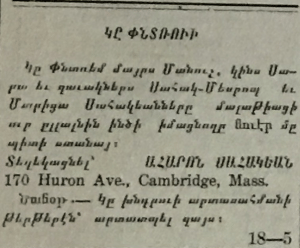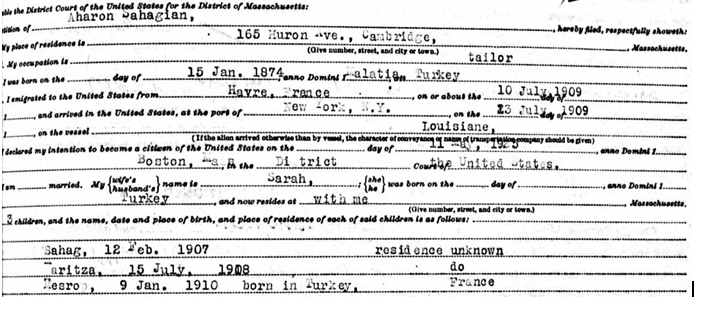




 |
 |
 |
 |
 |
VIP Forums Muzblog Chat Games Gallery. Ôîðóì, ìóçäíåâíèêè, ÷àò, èãðû, ãàëëåðåÿ. |
||||
|
||||||||
| Diaspora News and events in Armenian and other diasporas. |
The Search for Family during the Chaos of Genocide |
LinkBack | Thread Tools | Display Modes |
|
|
#1 (permalink) |
|
Top VIP VIP Ultra Club
Join Date: Jan 1970
Posts: 12,055
Rep Power: 69
 |
Special for the Armenian Weeky
Have you ever wondered how Armenian families were able to reconnect during and after the genocide before the communication tools of today? There were those trapped in the diaspora, mostly men, desperate to hear any news of their families. At the same time, there were thousands of Armenians trapped in varied circumstances in the homeland and in Syrian refugee camps, often children with scant information about their families. Recently, I was in the Hairenik building glancing through old issues of the “Hairenik Daily” and ran across the advertisements placed in the paper in hopes of learning the whereabouts of relatives. They start slowly at first in 1918 and then build in earnest in 1919. The desperation is palpable in just a few words beginning with, “Guh pndrem” (“I am searching”)… “Gu pundrem ginus yev zavagnerus…” “I am searching for my wife and children Dikran and Artin Koyoghlian from Tomarza –Haji Melkon Koyoghlian.” “Gu pundrem…” “I am searching for my mother Manoush, my wife Sara, and my children Sahag-Mesrob and Maritsa Sahagian of Malatia.”  This ad was placed in 1919 by Aharon Sahagian of Cambridge, Mass. On his naturalization papers filed in 1927, we learn that Aharon’s wife Sara had been located and was now residing with him in Cambridge. We also learn from these papers that there was another son named Mesrob that was born soon after Aharon had left Malatia in 1910, and that son was now living in France. This ad was placed in 1919 by Aharon Sahagian of Cambridge, Mass. On his naturalization papers filed in 1927, we learn that Aharon’s wife Sara had been located and was now residing with him in Cambridge. We also learn from these papers that there was another son named Mesrob that was born soon after Aharon had left Malatia in 1910, and that son was now living in France.However, for the location of Sahag and Maritsa, it is simply stated “residence unknown.” I do not know the story of this family, but can imagine the cruel reality of those words, residence unknown. On the other side of the world, those that had survived the trauma of the genocide were reaching out to find relatives known to have reached the United States. In the periodical “Gotchnag,” we find lists of those in the care of American institutions accompanied by the name of their relative presumably living in the United States. I found my grandfather’s first cousin, Hairabed Der Manouelian, listed in the American orphanage in Kharpert. It is the only evidence I have for how Hairabed made contact with his father, Asadour, who was living in Rhode Island. It would take more than five years for Hairabed to be reunited with his father. My grandfather joined him pretending to be another of Asadour’s sons.  In another issue of “Gotchnag,” we find a list of 72 women who were rescued from Turkish harems and were then living under American protection in Kharpert. How many were never rescued? We will never know, although their children and grandchildren are coming forward today to reclaim their Armenian identity. In this, the 100th anniversary of the beginning of the greatest crime committed against our people, it seems appropriate to recall the herculean efforts at stopping the complete annihilation and attempt at repairing the family ruptures. Today, there are a handful of people helping Armenians to recapture the family connections lost through time and memory. Of particular note is Mark Aslan, who manages the Armenian Immigration Project (http://arslanmb.org/ArmenianImmigrants/shiplists.html). He has done an incredible job of abstracting and indexing records and placing them in one location for easy access and searching. Through his efforts, and those who participate in Tracy Rivest Keeney’s Armenian Genealogy Facebook page, the advertisements from the Hairenik will be translated and made available. Their cause is noble. It is not the only way to honor our ancestors, to fight the continued crimes against Armenians, but it surely belongs on the list, and I am thankful that Tracy and Mark and those like them have taken up the cause. Special for the Armenian Weeky Have you ever wondered how Armenian families were able to reconnect during and after the genocide before the communication tools of today? There were those trapped in the diaspora, mostly men, desperate to hear any news of their families. At the same time, there were thousands of Armenians trapped in varied circumstances in the homeland and in Syrian refugee camps, often children with scant information about their families. Recently, I was in the Hairenik building glancing through old issues of the “Hairenik Daily” and ran across the advertisements placed in the paper in hopes of learning the whereabouts of relatives. They start slowly at first in 1918 and then build in earnest in 1919. The desperation is palpable in just a few words beginning with, “Guh pndrem” (“I am searching”)… “Gu pundrem ginus yev zavagnerus…” “I am searching for my wife and children Dikran and Artin Koyoghlian from Tomarza –Haji Melkon Koyoghlian.” “Gu pundrem…” “I am searching for my mother Manoush, my wife Sara, and my children Sahag-Mesrob and Maritsa Sahagian of Malatia.” This ad was placed in 1919 by Aharon Sahagian of Cambridge, Mass. On his naturalization papers filed in 1927, we learn that [...] Special for the Armenian Weeky Have you ever wondered how Armenian families were able to reconnect during and after the genocide before the communication tools of today? There were those trapped in the diaspora, mostly men, desperate to hear any news of their families. At the same time, there were thousands of Armenians trapped in varied circumstances in the homeland and in Syrian refugee camps, often children with scant information about their families. Recently, I was in the Hairenik building glancing through old issues of the “Hairenik Daily” and ran across the advertisements placed in the paper in hopes of learning the whereabouts of relatives. They start slowly at first in 1918 and then build in earnest in 1919. The desperation is palpable in just a few words beginning with, “Guh pndrem” (“I am searching”)… “Gu pundrem ginus yev zavagnerus…” “I am searching for my wife and children Dikran and Artin Koyoghlian from Tomarza –Haji Melkon Koyoghlian.” “Gu pundrem…” “I am searching for my mother Manoush, my wife Sara, and my children Sahag-Mesrob and Maritsa Sahagian of Malatia.” This ad was placed in 1919 by Aharon Sahagian of Cambridge, Mass. On his naturalization papers filed in 1927, we learn that [...] [img][/img] More... |
|
|

|
|
|
|